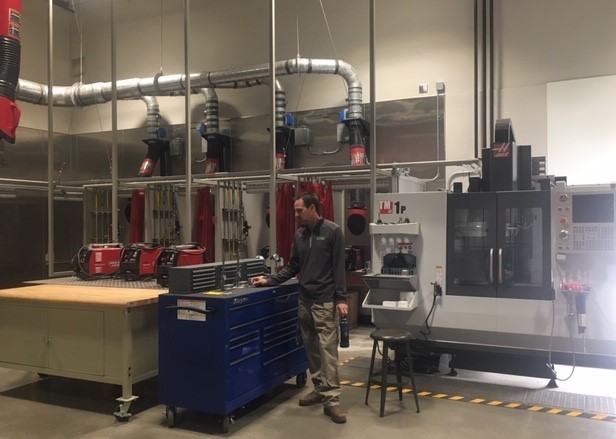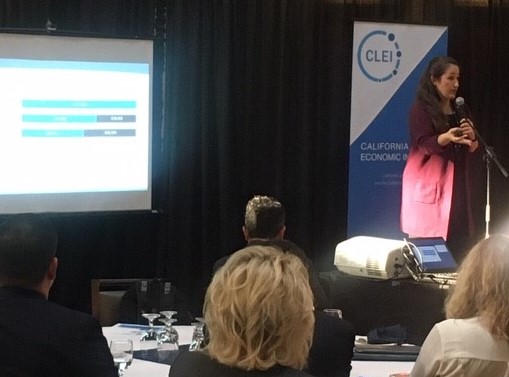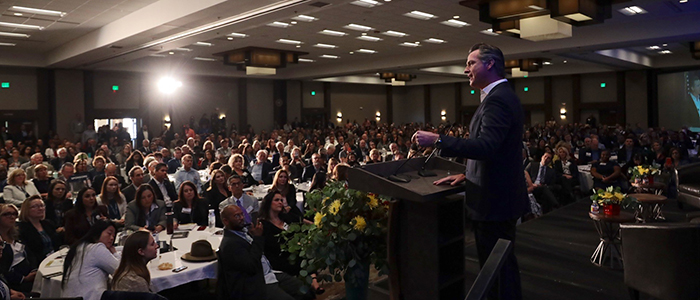2019 California Economic Summit
By Patrice Mascolo

The 2019 California Economic Summit took place in Fresno on November 7-8, marking the eighth annual gathering of over 900 civic, business and community leaders from across the state to create a shared economic agenda, one developed by private, public, and civic champions from the state's diverse regions with the goal of expanding prosperity for all. I was privileged to attend this Summit to represent Mendocino County along with Mary Anne Petrillo the CEO for West Business Development Center.
I was impressed with the caliber of people in attendance and grateful for the opportunity to attend the Summit. There were many confident amazing minds, innovative ideas, and big thinkers.
I am grateful to Redwood Coast Rural Action for sponsoring my registration fee and to the Community Foundation of Mendocino County for funding my travel expenses.
Over the two-day Summit, leaders gathered to tackle some of California’s most pressing problems with a focus on Inland California, while keeping the triple bottom line – economy, equity and environment – in mind. Those issues include Housing, Mobility and Connectivity, Lifelong Learning and Ecosystem Vitality and Working Landscapes.
Below are the work groups I attended and key highlights from each.
Tour of High School Career Tech Ed Programs
Career Technical Education Charter High School, (CTEC), features dual enrollment with Fresno City College enabling students to receive a High School diploma and an AA degree. There are two pathways they can chose from: Advanced Manufacturing and Commercial Construction.

Duncan Polytechnical featuring an Innovative Design and Applied Technology Academy with pathways in construction, manufacturing, automotive, heavy truck repair and welding, nursing, pharmaceutics, rehabilitation, and healthcare. They receive industry certificates and internships are available at local business where many are hired after the internship ends. They have about 1,000 students with 50% Latino, 40% Asian and 85% eligible for free lunch.
Northern California Regional Dialogue
The state was divided into eight economic regions to provide a framework and consideration for the state role in spurring and supporting regional economic strategies. This would focus on systems and regional economic development planning/engagement processes and not individual Sate program issues. The results would be locally driven and tailored, comprehensive and integrated, with cross-sector responsibility and contributions.
The eight Regions are:
- Bay Area (9 counties, includes Sonoma)
- Inland Empire
- Los Angeles/Orange
- Central Coast
- Northern California (north of Sacramento)
- Sacramento
- San Diego/Imperial
- San Joaquin Valley
At the Northern CA Regional meeting there was concern that the region was created out of convenience and not clearly represented by all areas. Many county representatives were not invited to the initial meeting last year in Redding. These were mostly the coastal counties and smaller northern counties. There was discussion to split into 3 regions, as many of the areas are rural, have a large tourist economy, and have natural resources with much of it being Federal land. But we made the decision to make sure all areas in the Northern CA region are being heard and not to split. There was talk of having subsections for the Coast, Inland and Sierras.
Ideas discussed at the meeting:
- Schools working towards trade skills and a dual education with AA degrees and certificates through internships which would give more respect to the trade industry and their need for workers. This could be integrated into the High Schools
- Workforce collaboration with community colleges, trade schools and businesses
- Focus on Forest Health, rural communities traditionally think of forest products as economic opportunities, change this mind set to focus on working landscapes
- Our region has a challenging geography - how to build trust and relationships
- Need federal and state funding alignment
- Limited funding access in rural areas, they lack philanthropic opportunities. There is a need for corporate and foundation money
- Broadband – include this in all domains as an economic driver
- Tourist economy – there is a negative impact from tourists in some areas such as the high level of vacation rentals that cause a lack of residential housing
- Local wood for local houses - use as an economic tool
Latinos in the Economic Transformation of California

- Latinos are experiencing the highest decline in home ownership after the African American population, with lack of adequate housing highest for Latinos
- Educational attainment is part of the pathway to home ownership and becoming middle class. High costs and high debt inhibit owning a home
- High School graduation rate is increasing in the state for Latinos
- Only 13% of Latinos have a 4-year college degree or higher
- Only 25% of 4th graders have achieved math proficiency; this is the lowest for all demographics
- Education is still the best way to help small businesses and for Latinos to attain middle class
- Business ownership is at 43.9% but they are usually small businesses with a low number of employees and low receipts and sales
- There is a need for more training and workforce programs in the colleges
- If these businesses are thriving, then the local economy is thriving. The CA economy is directly affected by the Latino population income
- There has been progress in closing gaps, but significant disparities remain
- Need policies to help with student debt, education, training opportunities and asset building
Lifelong Learning: Strong Workforce Program – Cradle to Career
- Initiatives:
- Longitudinal Data System,
- Cradle to Career “Early Adopter Grants”
- Engagement Initiative
- Employee Financing Lifelong Learning – Finance the full cost of college, equitable College Aid for Students
- CA is one of only 4 states that does not have a statewide integrated data system to track students through the school systems. This data system is used for:
- Research and evaluation
- Program planning and optimization
- Tools to support families and education
- Cradle-to-Career education initiatives begin at pre-natal and continues into the workplace
- Recommend a grant program to materially improve dual generation outcomes and prepare young people for high-wage jobs in their communities
- Most adults without a college degree are people of color and most of them work low income jobs. The barriers to going back to college or starting college as an older student are:
- Returning and adult students have barriers to financial aid
- They have work and family obligations
- Difficulty in transferring credits
- Campus culture for young people and not adult students
- Policy recommendations:
- Support adult student service needs
- Connecting training programs to degrees
- Expand aid eligibility for adults
- Eliminate administrative hurdles to degree conferral
Prosperous Economies, Thriving Workers: Regions Up Prosperity Strategy
This is a model for action at the Regional level.
- Need to bring employees into the dialogue for workforce development and they need to believe there will be outcomes that are credible
- This should be region based and not just for the big city employee
- Need pathways for students/employees that translate to real jobs
- Need asset mapping in the regions, who will lead this?
- Need a measurement and evaluation process
- Policy ideas:
- Develop new curriculums that support the digital age
- Less barriers and more outcomes
- Accommodate the differences between urban and rural area
- Have workforce plans that bring in finances from the state
Moving a Regions up housing agenda in 2020
- Promising practices:
- Housing stands in the way of equitable solutions. Pledge resources to help leaders in the field
- Start with modest efforts and be affordable for the local workforce
- Regional funding measures and approaches needed as state funding is not enough
- Grassroots Advocacy partners on the ground to show up at the meetings
- Redevelopment reforms needed to be given back to cities
- Streamline and increase the time needed for the approval for housing
- Build Smaller units and units that people can buy such as condos. Larger homes drive people out of the market. Get rid of mini mansions, land should not be used for these larger houses
- Repurpose malls into villages and build up. Have apartments above stores
Governor Gavin Newsom's keynote address

The Governor’s speech focused on California’s strengths and the work being done to address challenges. His speech was positive, humorous, and personable.
“We are a universal state, the most diverse state and the world’s most diverse democracy. The world looks to us to see if it’s possible to live, advance and prosper together across every conceivable difference,” said Governor Newsom. “Then you travel the state…and start to realize there are universal truths. Everybody wants to be protected. Everybody wants to be respected and everyone wants to be connected in some way shape or form.”
Governor Newsom’s Regions Rise Together, a partnership with California Forward, is an effort to bring together diverse leaders in every region over the course of the next year so that an inclusive and comprehensive plan is developed that will lift every part of California.
Additionally, to help close digital divides across the state, the Governor's Office will be developing an inclusive “Broadband for All” plan for the state.
His key statements were:
- We practice pluralism
- We don’t tolerate diversity we celebrate diversity
- We all want to be connected, we love our sense of place, our community
- We have the lowest unemployment in CA history
- We lead the nation in startups with more patents and the best college and university system in the country
- We are investing an historic amount of money and efforts to address the issues and not by tearing anyone down
- We are focusing on preemies, early head start, special education, and quality educators
- We are living within our means and balancing the budget
- We are all in this together
- We need to fill the gaps, break things down and focus
- We need idealism, authenticity and to maintain our sense of purpose
###
Patrice Mascolo, M.S. is the Program Manager for Healthy Mendocino. She has a master’s degree in molecular biology and enjoys working outside the science arena in the nonprofit sector creating collaborations and connections. She previously worked at Plowshares Peace and Justice Center.

